Mums are one of the most popular types of plants that you can grow in your yard because they come in a wide variety of colors and shapes and are relatively easy to look after. But, before you make the trip to the garden center, you should do a bit of research into how often you should water mums because it is essential for their wellbeing.
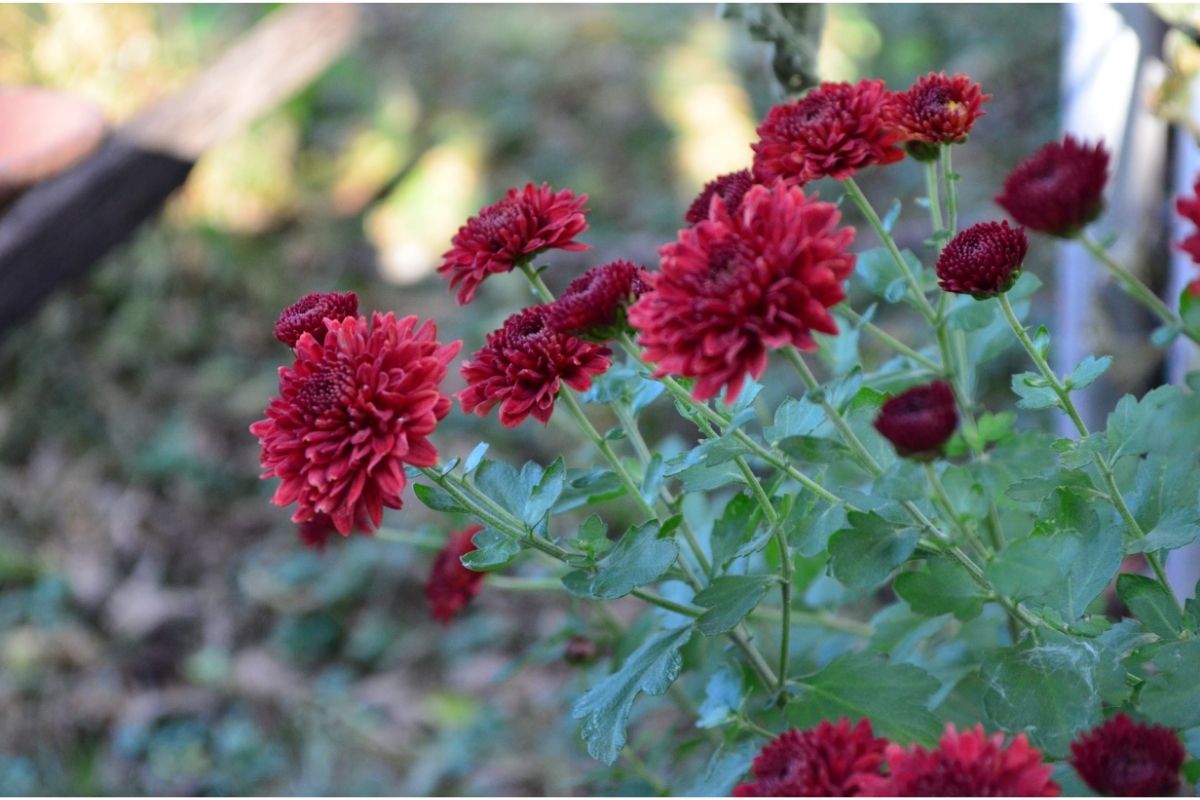
What Are Mums?
Mums are also known as Chrysanthemums and are a big group of perennials plants which means that they flower every year and can even get bigger each time.
This is because only the stems die during winter, but they stay healthy which allows the mum to regenerate the following year.
Sometimes, the flowers on a mum can reach the size of a football and can produce flowers in a variety of colors that can survive all throughout summer and autumn.
Chrysanthemum flowers are the world’s second most popular flower, behind roses.
Types Of Mums
Gardeners enjoy hundreds of distinct species of chrysanthemums, which are frequently categorized based on factors like bloom duration, shape, color, size, and petal arrangement.
Plants are sometimes categorized into eight separate chrysanthemum plant kinds to ease the procedure for amateur growers.
1. Single Blooms
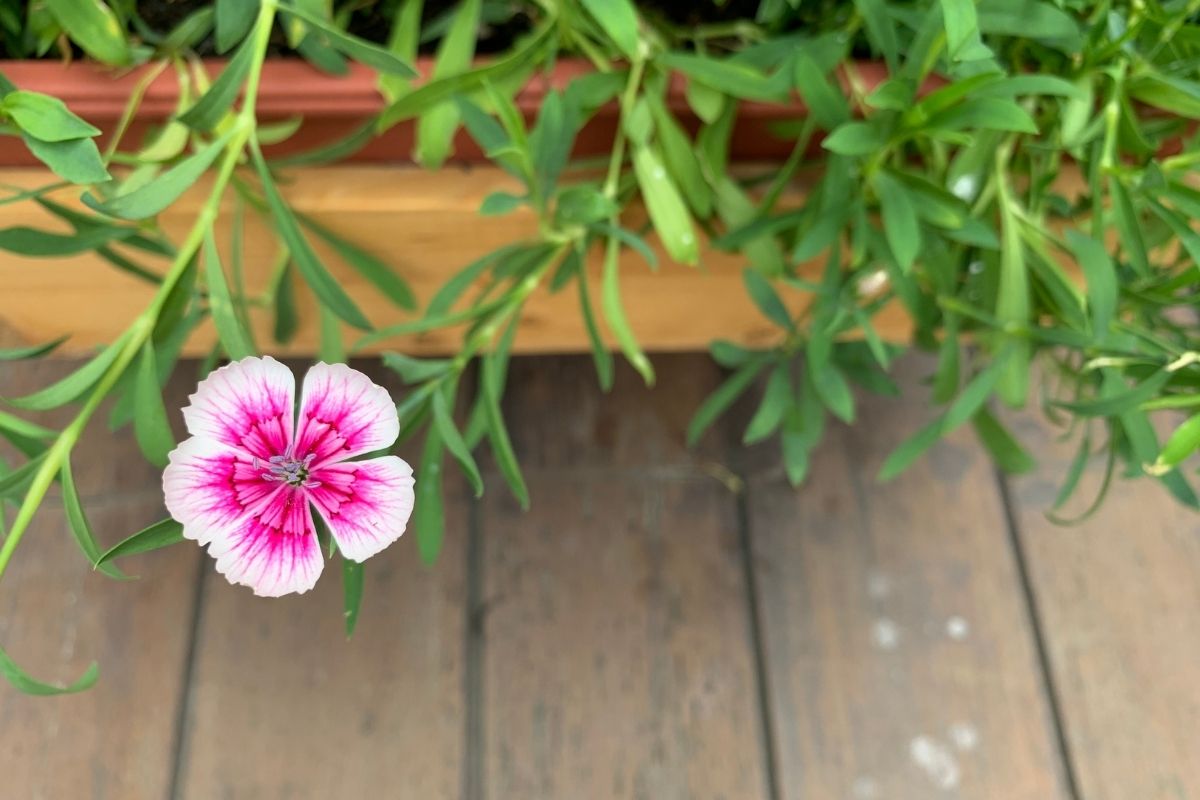
Because of their white petals and yellow cores, these mums resemble daisies. The key distinction is that the centers are slightly bigger than in daisies, and the petals are evenly spaced all around them.
Mums have a bushy appearance when they develop, and they normally reach a height of 2-3 feet, while some lesser types never exceed a foot.
Sometimes there is just one petal per stem, while other times single-bloom plants develop in groups.
Icy Isle, which resembles the yellow-and-white daisy, and Fire Island, which has a yellow core and red petals with yellow stripes, are two of the variants.
2. Spider Blooms
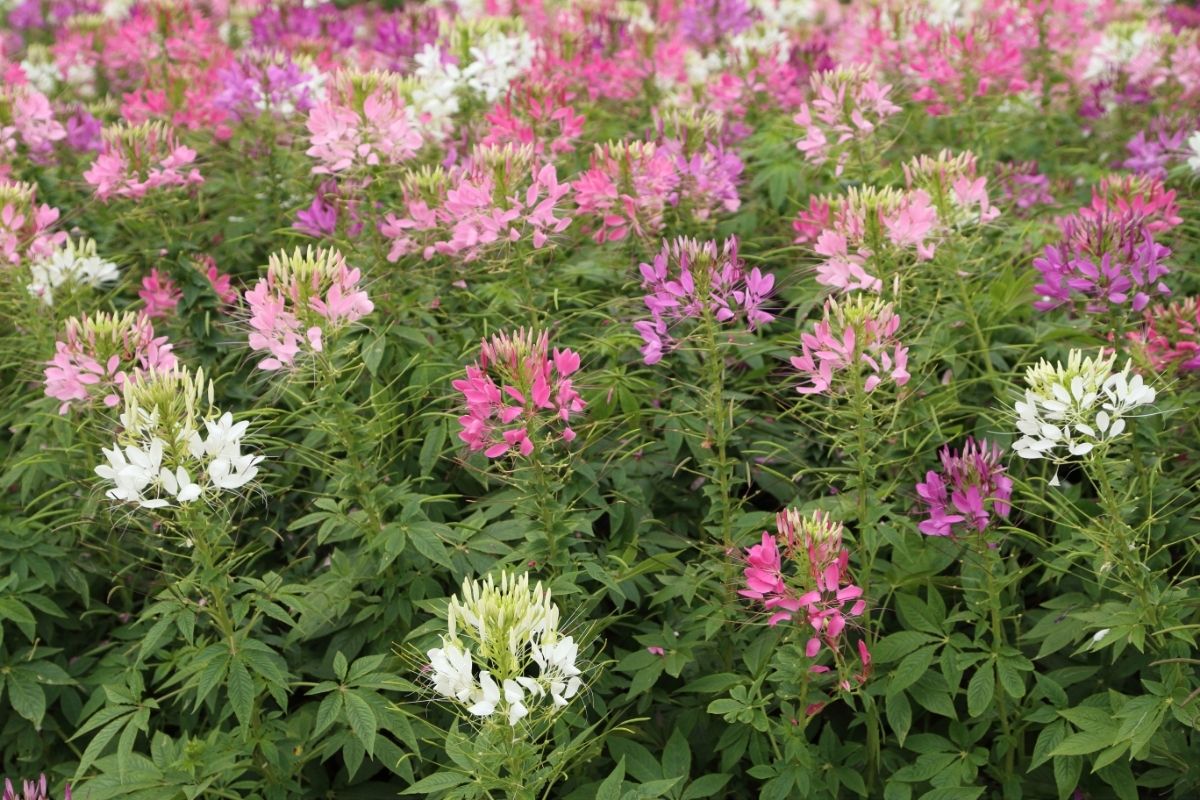
These mums have long and slender petals that resemble spider legs. Despite being long and tubular, the petals frequently branch out in all directions, creating a lacy and exquisite appearance.
Evening Glow, one of its variations, has petals that range from rose to bronze in hue, whilst Symphony has lacy petals that range from bronze to yellow in color.
Some cultivars are white. The Chesapeake, another variation, is at least six inches tall and has petals that vary from extremely fine to coarse. Petal hooks at the ends of spider blossoms are also present.
3. Quilled Blooms
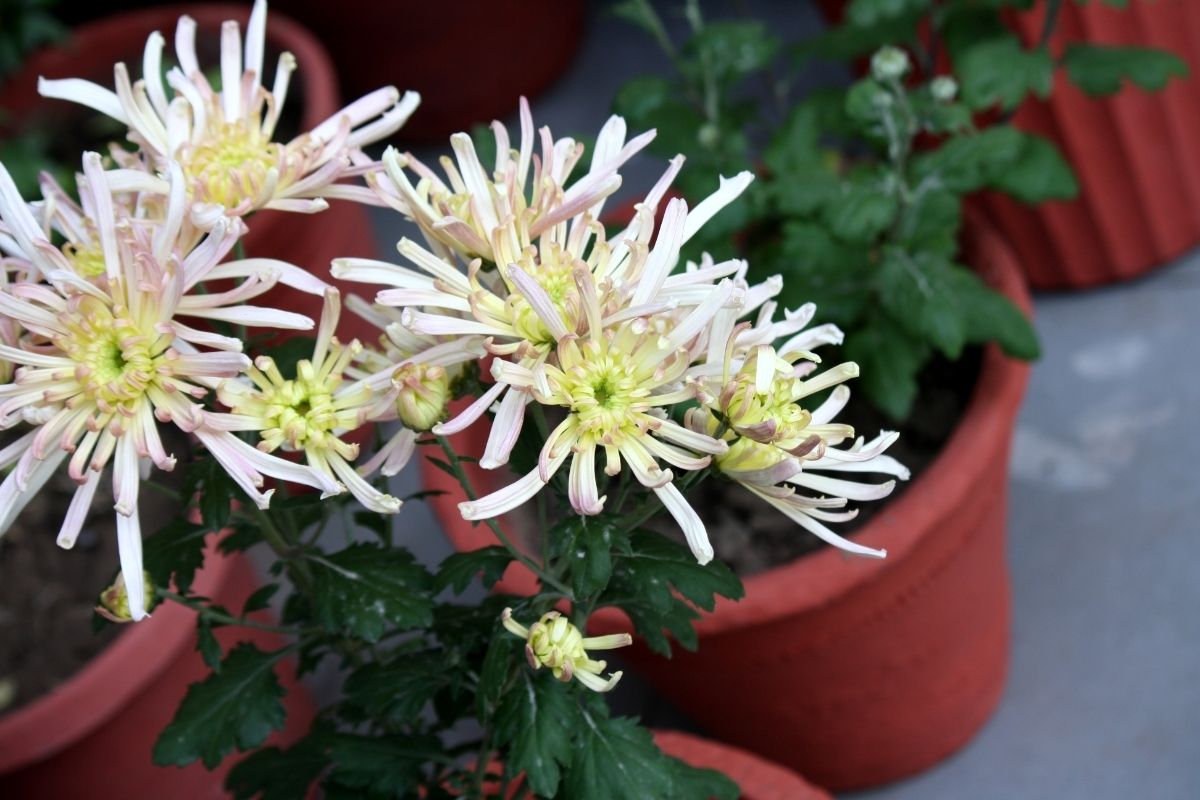
These mums feature spiky, quill-like petals, as the name indicates. The petals are quite thin, with some cupping up towards the tip. In fact, because of the cupped edge, some petals might resemble a spoon.
Some of its variants are Lola, which is quite enormous and has lovely lavender petals, and Kings Delight, which is also quite large and has lovely pink petals.
Quilled flowers are open topped with no open center, and some types, such as the Toffee, may reach a height of 6 inches or more.
4. Pompons
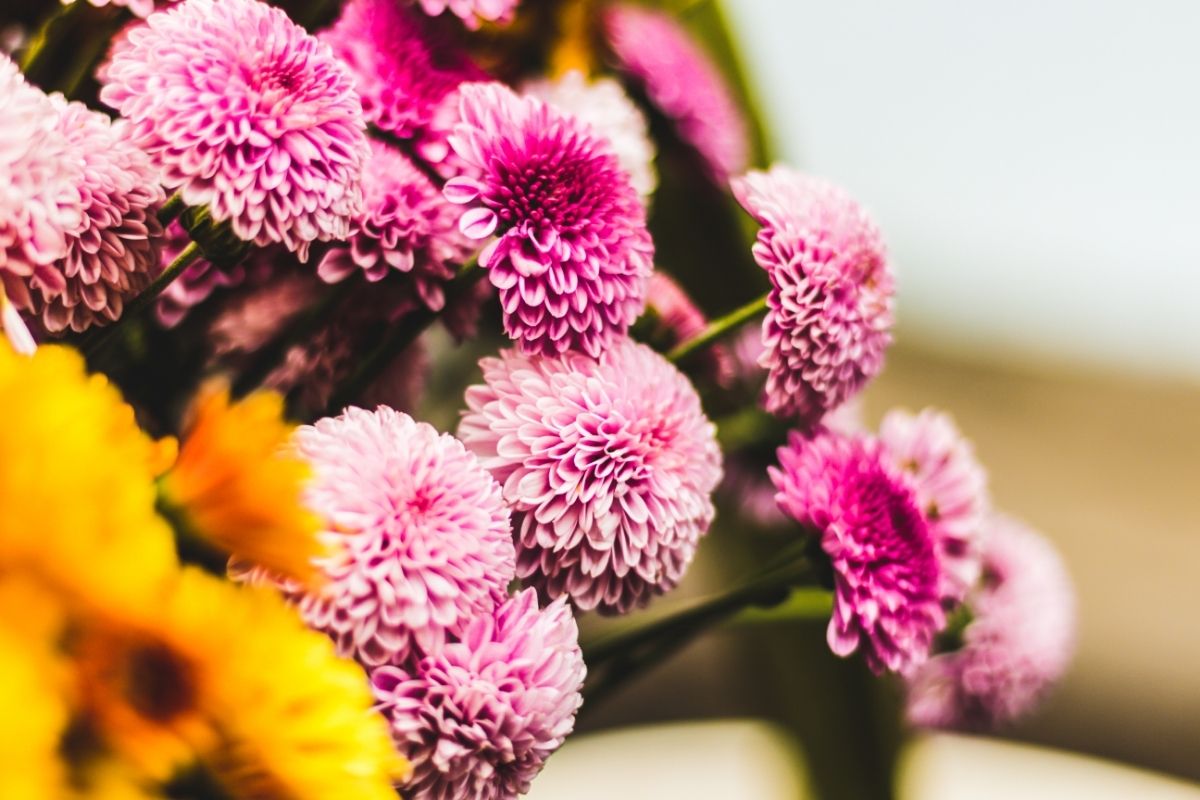
The heads of these mums, known as Pompons rather than Pompoms, are globe-shaped and have short petals that conceal their disc. When they are little, they are referred to as button mums.
The Moonbeam variety has huge flowers that are solid-white in color, but the Yoko Ono type has very few blossoms that are generally extremely green.
The Moonbeam variety may reach a height of two to three feet. Pompons start off flat but round out as they age, with flowers up to four 4-inches broad.
5. Anemone
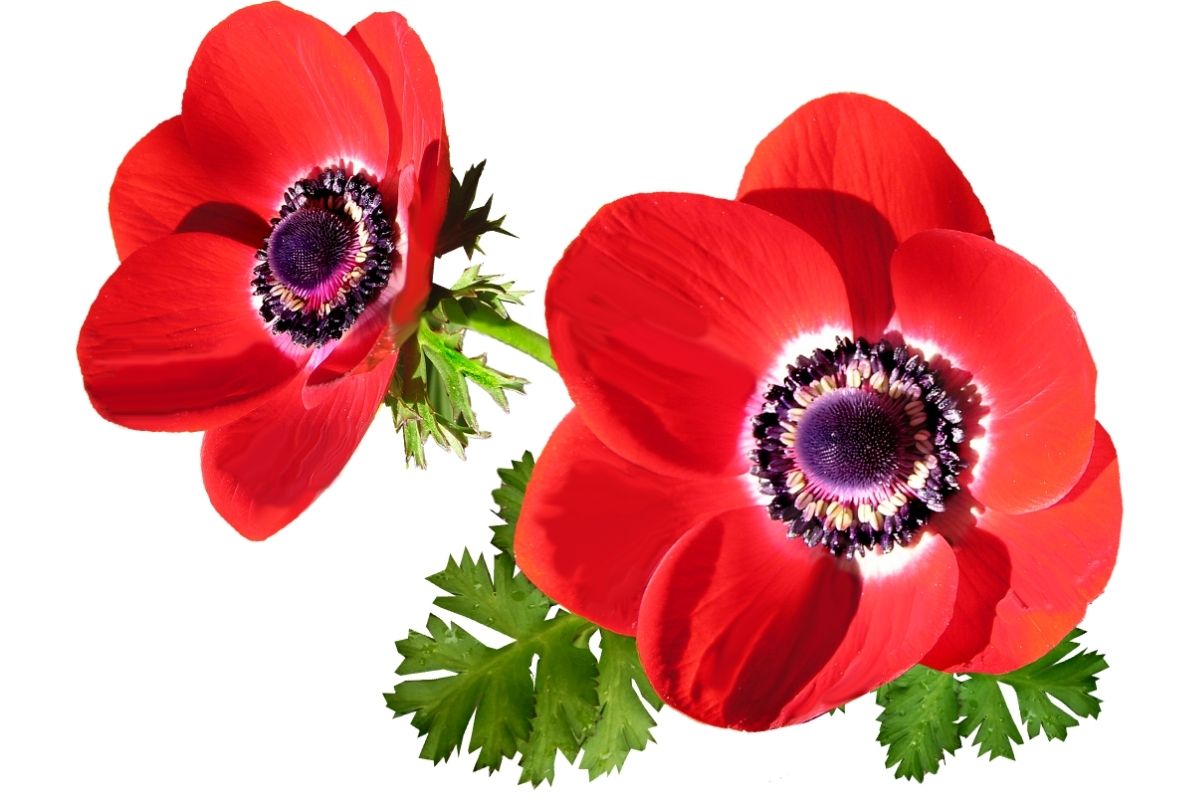
These flowers contain a center disc surrounded by petals, with the difference that the petals are cylindrical in form and produce a cushioned look.
The Angel variety of this type of mum stands out because it has a yellow center and little lavender-colored petals that create the cushion, as well as larger outside petals that are mostly dark purple with white tips.
The Anemone mums, which have a raised cushion-like core, are ideal as disbud can grow to be at least four inches tall.
Growing Mums
The mums sold at garden stores are commonly referred to as “hardy mums”. When shopping for mums, be sure to read the label to ensure you’re getting hardy garden kinds that are suited for your planting zone.
Local nurseries and garden stores will frequently showcase types native to the area. Avoid buying mums from florists since their mums are different, less hardy flower kinds.
Planting mums in the spring allows the perennial plant time to grow and adjust to its new garden habitat.
Mums are readily available at garden stores and nurseries in both the fall and spring, but planning ahead is essential for effective planting.
It’s tempting to buy those large lovely fall mums you see throughout autumn, but smaller spring mums are really a better investment in terms of durability.
The root system grows stronger over the summer and fall, increasing a plant’s capacity to withstand the winter. Planting in the spring will also result in a larger bloom the following season.
Although some autumn mums can survive winter if planted promptly, spring-planted mums have a far better chance.
Planting moms near together might be enticing. Spring mums are smaller and don’t seem to fill up a garden space as effectively.
Keep in mind, however, that most well-planted mums will reach up to 3 feet in height and breadth by autumn.
Mums, like many perennials, grow larger each year. Even if your flower bed appears sparse when you initially plant your mums, it will grow up over time.
The appropriate spacing of mothers is critical for plant health. Plants that are overcrowded compete for nutrients, have root system problems, attract pests, and are susceptible to disease.
Following the plant spacing instructions for your mum variety improves the health of your garden and preserves your time and money investment.
The rate at which mums grow is affected by a variety of factors. Different types have varying development rates and mature sizes.
It may take several years for plants grown from seed to attain their maximum development potential.
Mums planted from existing garden center plants and divisions have an advantage in terms of the growth season.
Watering, fertilizing, and pinching mums properly boosts the plant’s fullness and growth possibilities.
RELATED: Nature is Sweet As! 10 Different Types Of New Zealand Trees
How Often Do You Water Mums?
Mums require consistent moisture to thrive. Watering should be done on a regular basis during the spring, summer, and fall.
Watering can be postponed until the earth thaws in the spring if the ground freezes in the winter. Watering in the morning, to a depth of six to eight inches, is advised.
Watering frequency will vary widely based on the mothers’ location and climate. Test the soil with your finger if the weather has been hot for a while.
Water your mothers if the weather is dry and dusty. The hotter and dryer the weather, the more water your mums will need. During wet seasons, you may not need to water them at all.
The best way to water mums is to provide moisture straight to the roots of the plants. This keeps moisture from being trapped in the dense vegetation.
Soaker hoses can deliver consistent, moisture directly into the soil, and a water timer eliminates the need to remember to water manually.
It is critical for moms to have a strong root system. The deeper the roots, the better the plant’s chances of surviving strong cold and even drought circumstances.
Water your soil down to a depth of six to eight inches to stimulate deep root development. Insert a stick into the soil and check to see whether it’s moist at that depth.
Summary
To round up, there are numerous factors that will determine how often you should water mums but if you follow the guidance in this piece and keep a close eye on how the plants are responding, you should have it figured out in no time.
Your mums will thrive if you follow these guidelines which is to provide the moisture directly to the roots, test the soil around the plants if the weather has been hot and sunny for a while, and do not water them as much or at all if you have been experiencing a lot of rain.







